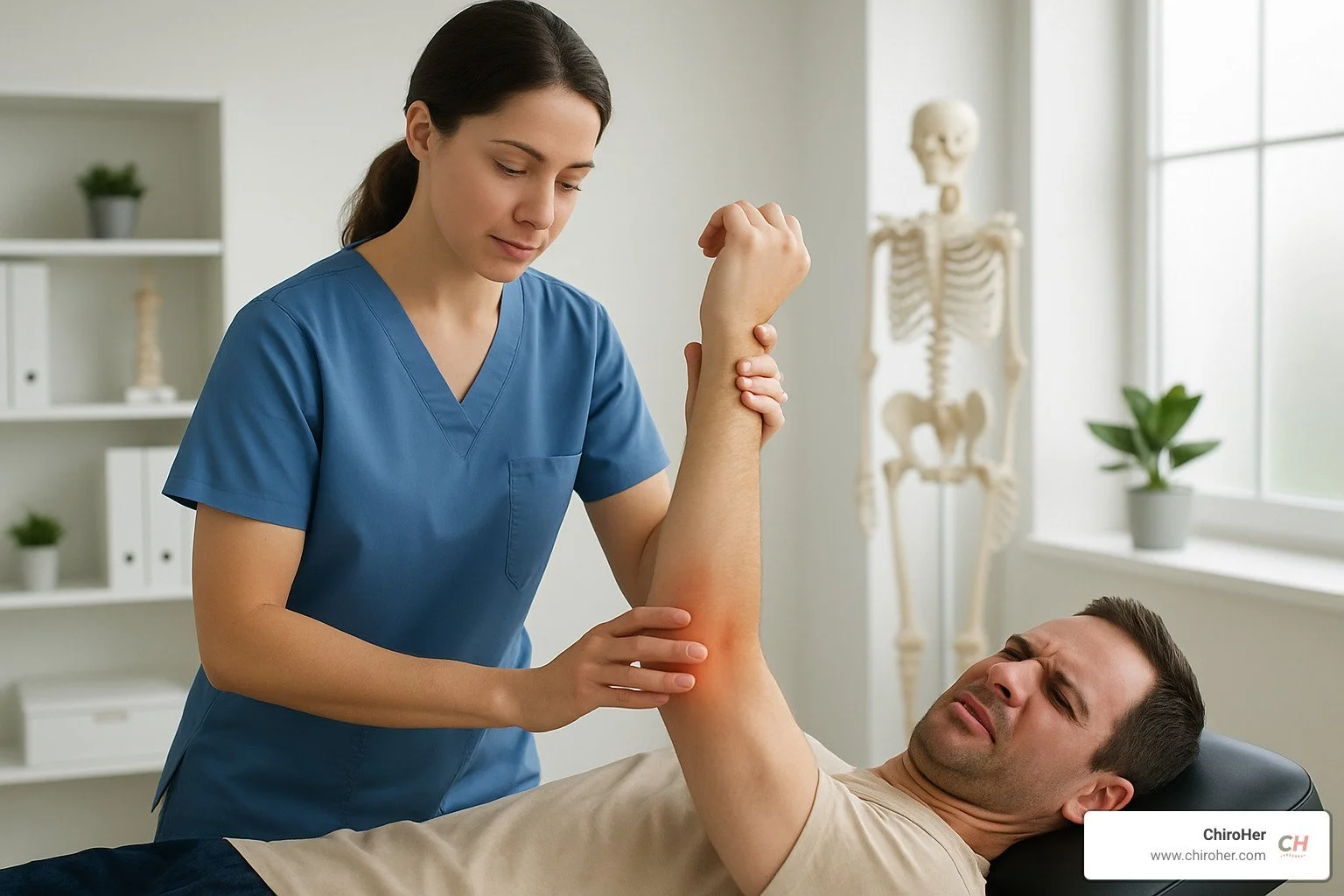Battle of the Therapies – Chiropractor or Massage for Tendonitis Relief
Why Choosing the Right Treatment Matters for Your Tendon Pain
Chiropractor vs massage for tendonitis - which approach will get you back to your active life faster? Here's what you need to know:
Quick Answer:
Chiropractic care targets root causes through spinal alignment, joint manipulation, and advanced modalities like ultrasound therapy
Massage therapy focuses on soft tissue healing through techniques like deep transverse friction and myofascial release
Best results often come from combining both approaches, with 41% of massage patients seeking treatment for medical conditions like tendonitis
Recovery timeline averages 2-6 weeks with proper treatment
Tendonitis affects millions of people every year, causing that nagging pain in your shoulder, elbow, wrist, or knee that just won't quit. Whether you're dealing with tennis elbow from repetitive computer work or Achilles pain from your morning runs, the inflammation in those thick cords connecting muscle to bone can seriously impact your daily life.
The good news? You have proven treatment options that go beyond just "rest and ice." Research shows that over 4 million Americans seek professional help for tendonitis annually, and many find relief through hands-on therapies that address both symptoms and underlying causes.
I'm Dr. Michelle Andrews, founder of ChiroHer in Oklahoma City, and I've helped countless patients with the chiropractor vs massage for tendonitis question over my years of practice. My experience with athletes, busy professionals, and expecting mothers has shown me that the right treatment approach depends on your specific condition, timeline, and wellness goals.
Understanding Tendonitis: Causes, Symptoms, Healing Timeline
Tendonitis happens when the thick, rope-like cords connecting your muscles to bones become inflamed or irritated. Think of tendons as your body's strongest cables, designed to handle enormous amounts of force every day. When they get overworked, they develop tiny tears that trigger inflammation, pain, and that frustrating cycle of discomfort.
The usual suspects behind tendonitis include repetitive motions like endless typing or tennis swings, sudden activity spikes when weekend warriors go from couch to marathon training, and age-related changes that make tendons less flexible after 40. Poor posture during work or exercise doesn't help either.
You'll know tendonitis has arrived when movement becomes painful, the area feels tender and swollen, and morning stiffness makes you feel like the Tin Man before his oil can. Some people notice a crackling or popping sensation when they move, while others experience weakness that makes simple tasks surprisingly difficult.
Research from Harvard Health explains that while inflammation is your body's natural healing response, chronic inflammation can actually slow recovery and create bigger problems down the road. This is where understanding the chiropractor vs massage for tendonitis debate becomes crucial for your healing timeline.
Common Tendonitis Hot-Spots & Red-Flags
In our Oklahoma City area practice, we see certain patterns emerge with tendonitis locations. Tennis elbow strikes the outer part of your elbow and loves to target anyone who grips things repeatedly, while golfer's elbow hits the inner elbow from too much wrist flexion. Your shoulder might develop rotator cuff tendonitis from overhead activities, and thumb pain from texting has become so common we practically see it daily.
Down in your lower body, jumper's knee affects the area below your kneecap, Achilles tendonitis makes every step a reminder of yesterday's run, and IT band syndrome creates that nagging outer thigh and knee pain.
Some warning signs demand immediate attention though. If you hear a sudden pop followed by severe pain, can't move the joint at all, or notice signs of infection like fever and red streaking, don't wait. Numbness or tingling suggests nerve involvement and needs professional evaluation right away.
Why Rest Alone Isn't Enough
While rest feels logical during the painful phase, simply avoiding activity won't fix the underlying problems that caused your tendonitis in the first place.
Scar tissue loves to form when tendons heal without proper guidance, creating adhesions that limit your flexibility and strength long after the initial pain fades. The muscle imbalances and joint stiffness that contributed to your problem remain unchanged, setting you up for another round of pain once you return to normal activities.
What starts as acute tendonitis can morph into chronic tendinosis, where your tendon develops degenerative changes that are much harder to reverse. Extended rest also leads to deconditioning, making your muscles weaker and joints stiffer, which increases your re-injury risk.
Most tendonitis takes two to six weeks to heal with proper treatment, but this timeline depends heavily on getting the right care at the right time.
Chiropractic Care for Tendonitis Relief
Modern chiropractic reaches well beyond the spine. By correcting joint mechanics and easing soft-tissue restrictions, we lighten the daily workload on irritated tendons so they can heal.
Spinal and extremity adjustments restore normal movement patterns. When the shoulder blade glides correctly, the rotator-cuff tendons stop overworking; when the low back moves freely, stress on the Achilles drops. We follow each adjustment with targeted soft-tissue release to loosen scar tissue that keeps the tendon “stuck.”
Advanced tools—shockwave, cold laser, therapeutic ultrasound—speed cellular repair. WebMD notes ultrasound’s ability to boost blood flow and collagen production, often trimming weeks off recovery.
Rehabilitative exercises lock in the gains. You leave each visit knowing exactly how to load the tendon safely so it rebuilds stronger.
How Adjustments Lower Tendon Load
Joint restrictions change your body’s leverage. A stiff mid-back forces the elbow to compensate during a tennis serve; tight hips shift running forces into the knee. Adjustments normalize these mechanics and restore clear nerve signaling, creating an environment where the tendon can calm down instead of fighting constant overload.
Evidence-Based Modalities Used by Chiropractors
Ultrasound therapy: sound waves that increase circulation and break down adhesions.
EMS: currents that reduce pain signals and keep nearby muscles active.
Cryotherapy: precise cooling that tempers inflammation without stopping the healing cascade.
Using several approaches at once lets us treat pain and its cause in the same visit.
Massage Therapy for Tendonitis: Techniques & Benefits
Massage tackles tendonitis right where it lives—in the soft tissues. By easing muscle tension and improving circulation, it supports the body’s natural repair process without adding extra strain.
Key methods include:
Deep transverse friction: pressure applied perpendicular to tendon fibers to disrupt adhesions.
Myofascial release: lengthens the fascia that can strangle healthy movement.
Trigger-point therapy: quiets stubborn muscle knots that keep pulling on the tendon.
Fresh blood delivers oxygen and nutrients, while the relaxation response lowers stress hormones that slow healing. See more of our Manual Therapy options.
When Massage Speeds Tendon Repair
Acute phase (days 1–3): gentle lymphatic work limits swelling.
Sub-acute phase (days 4–14): cross-fiber friction guides new collagen into strong, parallel lines.
Chronic cases: deeper work breaks up long-standing scar tissue and restores mobility.
Self-Care Between Sessions
Ice for 15–20 minutes after activity, use slow eccentric exercises, and tweak ergonomics so you stop repeating the motion that started the problem.
Chiropractor vs Massage for Tendonitis Side-by-Side Breakdown
Think of tendonitis as a house with both foundation and interior damage. Chiropractic repairs the foundation (joint mechanics), while massage fixes the interior (soft tissues). Most people benefit from some of each.
Quick-Glance Benefits
Chiropractic: targets root biomechanics, offers modalities like ultrasound and cold laser, usually covered by insurance.
Massage: provides immediate muscle relief, lowers stress, and can be repeated frequently with little soreness.
Aspect Chiropractic Care Massage Therapy Initial relief 2–3 sessions 1–2 sessions Significant change 2–4 weeks 3–6 weeks Full recovery 6–12 weeks 8–16 weeks Early session frequency 2–3×/week 1–2×/week Ongoing maintenance Monthly Bi-weekly–monthly
What Does Science Say?
Both reduce pain and improve function, but research shows combined care often trims recovery time by 20–30 percent. Importantly, 41 percent of massage clients now seek help for medical issues such as tendonitis, underscoring its therapeutic value.
Combining Forces for Faster Results
When joints move better after an adjustment, massage can reach deeper layers with less discomfort. In turn, relaxed muscles help adjustments “hold” longer. Add a simple home-exercise plan and re-injury rates plummet.
Making the Right Choice & Next Steps
When to Start with a Chiropractor
Choose chiropractic first when you notice joint stiffness, nerve-type symptoms (numbness, tingling), or repeat flare-ups despite rest and ice.
When to Book a Massage First
Go straight to massage if you feel obvious muscle knots, your stress level is sky-high, or the tendonitis started only a day or two ago and swelling is the main problem.
Working With Both Providers Under One Plan
At ChiroHer we coordinate schedules, share notes, and adjust your program together, so you never get conflicting advice. One visit might start with gentle massage to loosen tissues, followed by an adjustment that now moves with ease.
Frequently Asked Questions
Is treatment safe while my tendon is inflamed?
Yes. We simply use lighter techniques—gentle joint mobilization or lymphatic massage—until swelling subsides.
How soon will I feel better?
Many notice easier movement right away. Meaningful relief typically appears within a week, with full gains over two to six weeks of consistent care.
Can these therapies prevent future flare-ups?
Regular chiropractic keeps joints moving well, massage keeps tissues flexible, and both include education so you spot early warning signs.
Final Thoughts
When you're dealing with tendonitis pain, the question of chiropractor vs massage for tendonitis doesn't have to keep you stuck in discomfort. Both approaches offer proven benefits that can help you get back to your favorite activities - whether that's playing tennis, typing without pain, or simply sleeping through the night.
The beauty of modern tendonitis treatment is that you have options. Chiropractic care addresses the structural issues that often contribute to tendon problems, while massage therapy focuses directly on the soft tissues that need healing. Each approach has its strengths, and often the best results come from combining both.
At ChiroHer, we've seen thousands of patients overcome tendonitis by taking a comprehensive approach that addresses both the symptoms and the root causes. Our experience with everyone from weekend warriors to busy professionals has taught us that sustainable wellness comes from understanding your body's unique needs and creating a treatment plan that fits your lifestyle.
The most important step is getting started. Tendonitis rarely improves on its own, and waiting often leads to chronic problems that are much harder to treat. Whether you choose to start with chiropractic care, massage therapy, or both, the key is working with practitioners who understand how these treatments work together.
Healing takes time, but you don't have to suffer through it alone. With the right combination of professional treatment, home care, and patience, most people see significant improvement in their tendonitis within a few weeks.
Ready to start feeling better? Schedule your personalized assessment with ChiroHer and let us help you create a targeted plan for lasting tendonitis relief.







